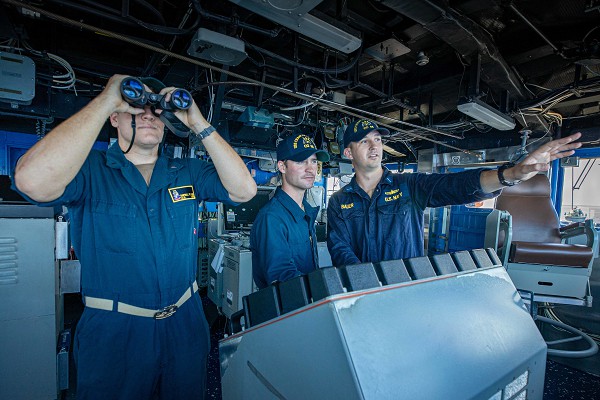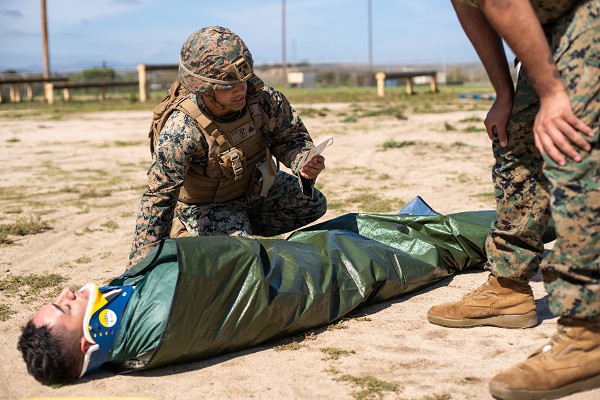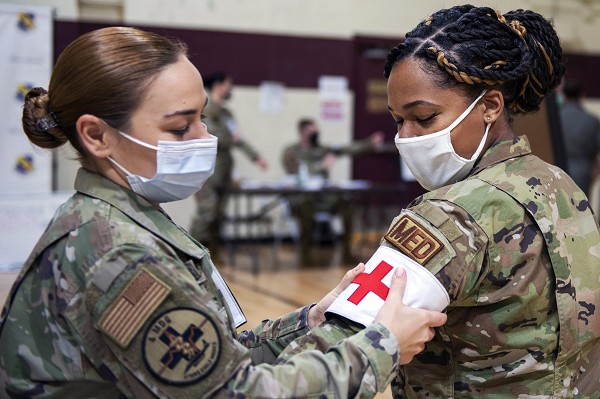- Details
- Hits: 1485
 South China Sea (July 25, 2022): In this photo by Navy Mass Communications Specialist 2 Justin Stack, sailors aboard the Ticonderoga-class guided missile cruiser USS Chancellorsville stand watch for Chinese military vessels as they conduct “freedom of navigation” exercises in the Taiwan strait. America routinely confronts challenges by the Chinese Navy to the safe passage of vessels in international waters.
South China Sea (July 25, 2022): In this photo by Navy Mass Communications Specialist 2 Justin Stack, sailors aboard the Ticonderoga-class guided missile cruiser USS Chancellorsville stand watch for Chinese military vessels as they conduct “freedom of navigation” exercises in the Taiwan strait. America routinely confronts challenges by the Chinese Navy to the safe passage of vessels in international waters.
South China Sea (July 25, 2022): A dramatic increase in Chinese military activity surrounding Taiwan (formerly known as Formosa) has American military commanders concerned an invasion of the island is imminent. Taiwanese authorities have reported “large incursions” by Chinese military forces into their territorial waters and airspace in recent months. In April, China flew the largest number of military jets into Taiwan airspace this year. This hyper-aggressive activity has led U.S. Admiral John Aquilino, the Pentagon’s Commander for the Indo Pacific region, to conclude that “a Chinese invasion of Taiwan is “closer than most think.”
America and her allies have pledged to defend the people of Taiwan in such an invasion, including a massive air and naval response. Given these realities, it is important to understand “how we got here” historically and what commitments the world has made to defend the free people of Taiwan.
After the allied victory in World War II, the Japanese relinquished control of China including the island of Taiwan located some 90 miles off the coast of the mainland. After a few years, however, civil war broke out between the Nationalist Chinese under Chiang Kai-shek and the Communists led by Mao Zedong over control of post war China. The Communists were victorious, and the Nationalist Chinese forces fled with their supporters to Taiwan in 1949. Unlike their communist neighbor, Taiwan developed a democratic, free market-based government that has been an economic miracle in Asia.
Read more: WILL CHINA INVADE TAIWAN? SURGING MILITARY ACTIVITY WARRANTS CONCERN
- Details
- Hits: 1299
 In this U.S. Army photo by Scott C. Childress, a Aeromedical Research Laboratory paramedic tests new items in a space utilization study at the Army’s School of Aviation Medicine’s DUSTOFF Training Complex, Ft. Rucker, Alabama. Here America’s military personnel train to become flight surgeons, critical care flight paramedics, and aviation nurse practitioners.
In this U.S. Army photo by Scott C. Childress, a Aeromedical Research Laboratory paramedic tests new items in a space utilization study at the Army’s School of Aviation Medicine’s DUSTOFF Training Complex, Ft. Rucker, Alabama. Here America’s military personnel train to become flight surgeons, critical care flight paramedics, and aviation nurse practitioners.
Ft. Rucker, AL. (July 27, 2022): One hour or less. That is not a guaranteed pizza delivery time, it is the time it takes for a wounded servicemember to arrive at an advanced medical facility via “Dust Off” medical evacuation.
The term “Dust Off” refers to the radio call sign given to the first aeromedical helicopter evacuation unit, the 57th Medical Detachment, in Viet Nam in 1962. This marked the birth of Medevac, the concept of using helicopters with highly trained medical crews to evacuate wounded directly from the battlefield to military surgical facilities. The goal is to dispatch, evacuate and deliver battlefield casualties within one hour no matter where the injuries occurred. This was dangerous business for pilots in Viet Nam as they were three times more likely to be shot down compared to other types of helicopter missions. Since then, highly trained air crews accompanied by medical teams achieved a 90.6 casualty survival rate in the wars in Iraq and Afghanistan.
Responsibility for training aviators and aeromedical teams falls to the School of Army Aviation Medicine at Fort Rucker, Alabama. Here military personnel train to become flight surgeons, critical care flight paramedics, and aviation nurse practitioners learning aviation medicine orientation, altitude physiology, toxicology, and how to use advanced protective equipment. The school teaches 160 unique courses and graduates upwards of 2,500 soldiers each year.
- Details
- Hits: 830
 A South Dakota Army National Guard Medic tests the blood pressure of a villager in the South American country of Suriname. Some thirty soldiers from the South Dakota National Guard travelled to this South American country to provide medical and dental services as part of America’s international partnerships for mutual aid. (U.S. Army photo courtesy of the North Dakota National Guard).
A South Dakota Army National Guard Medic tests the blood pressure of a villager in the South American country of Suriname. Some thirty soldiers from the South Dakota National Guard travelled to this South American country to provide medical and dental services as part of America’s international partnerships for mutual aid. (U.S. Army photo courtesy of the North Dakota National Guard).
Paramaribo, Suriname. (July 20, 2022): When we think of military medicine, images of wounded soldiers treated by medics while under fire come immediately to mind. What you may not realize is how powerful a diplomatic tool routine medical care can be.
A good example is the partnership between the South Dakota National Guard and the Surname Army. Sponsored by the U.S. Southern Command, medics from the South Dakota travelled to Paramaribo, Suriname each year to host medical clinics in remote villages to establish cooperation and lasting friendships.
- Details
- Hits: 1047
 In this photo by Marine Corporal Garrett Kiger, Corporal Ryan Nascimento, a chemical, biological, radiological, and nuclear defense specialist, reads off casualty information prior to transport during a Combat Lifesaver Course practical application at Camp Pendleton. The Combat Lifesaver Course is a three-day program that teaches Marines vital medical techniques to prevent loss of life on the battlefield.
In this photo by Marine Corporal Garrett Kiger, Corporal Ryan Nascimento, a chemical, biological, radiological, and nuclear defense specialist, reads off casualty information prior to transport during a Combat Lifesaver Course practical application at Camp Pendleton. The Combat Lifesaver Course is a three-day program that teaches Marines vital medical techniques to prevent loss of life on the battlefield.
Camp Pendleton, CA. (July 21, 2022): Its an ambush! Multiple explosions, bullets flying, a grievously wounded troop cries out medic! As the firefight rages, no medic is available and, without immediate care, this warfighter is going to die. What can the average troop do in such a situation?
In the past, many units suffered “preventable” deaths, losses that would not have occurred had warfighters received immediate lifesaving treatment. To ensure such care, the military established the Combat Lifesaver Course, an emergency medical training program for non-medical military personnel, to ensure critical care is delivered on the battlefield. For the Marines, the course is offered to all combat and support personnel who may find themselves treating seriously wounded comrades before medics can arrive. The Combat Lifesaver Course teaches crisis medicine, including essential tasks like applying a tourniquet, clearing the airway, or stopping the bleeding, things that buy valuable time and saves lives.
- Details
- Hits: 1515
 In this photo by Airman 1st Class Kimberly Barrer, Staff Sergeant Maria Monzi with the 4th Medical Readiness Squadron based at Seymour Johnson Air Force Base, North Carolina places a Red Cross arm band on fellow medical technician Staff Sergeant Candice Stafford as they prepare to administer COVID-19 immunizations. The military provides numerous avenues for recruits interested in a medical career.
In this photo by Airman 1st Class Kimberly Barrer, Staff Sergeant Maria Monzi with the 4th Medical Readiness Squadron based at Seymour Johnson Air Force Base, North Carolina places a Red Cross arm band on fellow medical technician Staff Sergeant Candice Stafford as they prepare to administer COVID-19 immunizations. The military provides numerous avenues for recruits interested in a medical career.
Bethesda, MD. (July 24, 2022): Can you stand the sight of blood? Are you able to keep your cool while responding to medical emergencies? Have you ever pictured yourself as a doctor, registered nurse, or medical technician?
If so, America’s armed forces might be the place to start.
Sadly, American servicemembers are going to get hurt doing their duty, even in peace time. Our nation prides itself on providing state of the art medical care to our active-duty troops no matter where they serve in the world. That is why the Army operates one of the world’s elite medical training programs based at the famed Walter Reed National Military Medical Center at Bethesda, Maryland.
Read more: Ever Dream Of Being A Doctor? Saving Lives While Serving Our Nation
- Details
- Hits: 921
 In this U.S. Army photo by Janet Wychock, Army Research Scientist for Chemistry Dr. Patricia McDaniel, left, works with research scientists Brian Hauck and Janet Jensen to explore chemical and biological detection technologies to protect warfighters in the field.
In this U.S. Army photo by Janet Wychock, Army Research Scientist for Chemistry Dr. Patricia McDaniel, left, works with research scientists Brian Hauck and Janet Jensen to explore chemical and biological detection technologies to protect warfighters in the field.
Aberdeen Proving Ground, MD. (July 22, 2022): It made its ghastly appearance in the trenches of World War I. It wounded 1.3 million combatants on both sides, killing over 100,000 soldiers and civilians. The demon that caused all this destruction was chemical agents, mostly mustard gas, fired back and forth indiscriminately by both the Germans and the allies. This was the world’s introduction to the grisly use of chemical weapons in combat, and it would not be the last.
The Russians have vast stockpiles of these weapons of mass destruction and has shown a recent willingness to use them against civilians in Syria. America must protect its troops from this lethal threat using all available technology.
That is the mission of the U.S. Army’s Combat Capabilities Development Command Chemical and Biological Center, led by Senior Research Scientist Dr. Patricia McDaniel and her highly skilled team of investigators/developers. Based at the Army’s testing facility at Aberdeen Proving Ground, Maryland, Dr. McDaniel directs two basic research and innovation exploratory science programs that are developing “Microsensors” capable of detecting the tiniest amount of chemical or biological agents. These low cost, light weight sensors alert America’s warfighters to the presence of chemical agents in time to protect themselves and their comrades.


